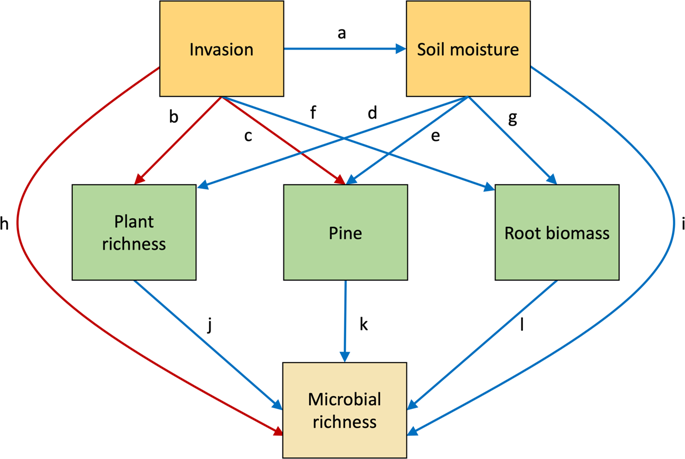Our official English website, www.x-mol.net, welcomes your
feedback! (Note: you will need to create a separate account there.)
Plant communities mediate the interactive effects of invasion and drought on soil microbial communities.
The ISME Journal ( IF 10.8 ) Pub Date : 2020-02-19 , DOI: 10.1038/s41396-020-0614-6 Catherine Fahey 1 , Akihiro Koyama 2 , Pedro M Antunes 3 , Kari Dunfield 4 , S Luke Flory 5
The ISME Journal ( IF 10.8 ) Pub Date : 2020-02-19 , DOI: 10.1038/s41396-020-0614-6 Catherine Fahey 1 , Akihiro Koyama 2 , Pedro M Antunes 3 , Kari Dunfield 4 , S Luke Flory 5
Affiliation

|
Soil microbiomes could play a major role in ecosystem responses to escalating anthropogenic global change. However, we currently have a poor understanding of how soil microbes will respond to interacting global change factors and if responses will be mediated by changes in plant community structure. We used a field experiment to assess changes in soil fungal and bacterial communities in response to plant invasion, experimental drought, and their combination. In addition, we evaluated the relative importance of direct versus indirect pathways of invasion and drought through changes in associated plant communities with structural equation models. We found that fungal communities were interactively structured by invasion and drought, where fungal richness was lowest with invasion under ambient conditions but highest with invasion under drought conditions. Bacterial richness was lower under drought but unaffected by invasion. Changes in the plant community, including lower plant richness and higher root biomass, moderated the direct effects of invasion on microbial richness. Fungal and bacterial functional groups, including pathogens, mutualists, and nitrogen metabolizers, were also influenced by plant community changes. In sum, plant communities mediated the effects of interacting global change drivers on soil microbial community structure, with significant potential consequences for community dynamics and ecosystem functions.
中文翻译:

植物群落介导入侵和干旱对土壤微生物群落的相互作用。
土壤微生物组可以在生态系统应对不断升级的人为全球变化方面发挥重要作用。然而,我们目前对土壤微生物如何响应相互作用的全球变化因素以及响应是否由植物群落结构的变化介导还知之甚少。我们通过田间实验来评估土壤真菌和细菌群落因植物入侵、实验性干旱及其组合而发生的变化。此外,我们通过结构方程模型相关植物群落的变化,评估了入侵和干旱的直接与间接途径的相对重要性。我们发现真菌群落是由入侵和干旱相互作用构建的,其中在环境条件下入侵时真菌丰富度最低,但在干旱条件下入侵时真菌丰富度最高。干旱条件下细菌丰富度较低,但不受入侵影响。植物群落的变化,包括植物丰富度降低和根生物量增加,减轻了入侵对微生物丰富度的直接影响。真菌和细菌功能群,包括病原体、共生体和氮代谢者,也受到植物群落变化的影响。总之,植物群落介导了相互作用的全球变化驱动因素对土壤微生物群落结构的影响,对群落动态和生态系统功能具有重大潜在影响。
更新日期:2020-02-19
中文翻译:

植物群落介导入侵和干旱对土壤微生物群落的相互作用。
土壤微生物组可以在生态系统应对不断升级的人为全球变化方面发挥重要作用。然而,我们目前对土壤微生物如何响应相互作用的全球变化因素以及响应是否由植物群落结构的变化介导还知之甚少。我们通过田间实验来评估土壤真菌和细菌群落因植物入侵、实验性干旱及其组合而发生的变化。此外,我们通过结构方程模型相关植物群落的变化,评估了入侵和干旱的直接与间接途径的相对重要性。我们发现真菌群落是由入侵和干旱相互作用构建的,其中在环境条件下入侵时真菌丰富度最低,但在干旱条件下入侵时真菌丰富度最高。干旱条件下细菌丰富度较低,但不受入侵影响。植物群落的变化,包括植物丰富度降低和根生物量增加,减轻了入侵对微生物丰富度的直接影响。真菌和细菌功能群,包括病原体、共生体和氮代谢者,也受到植物群落变化的影响。总之,植物群落介导了相互作用的全球变化驱动因素对土壤微生物群落结构的影响,对群落动态和生态系统功能具有重大潜在影响。











































 京公网安备 11010802027423号
京公网安备 11010802027423号